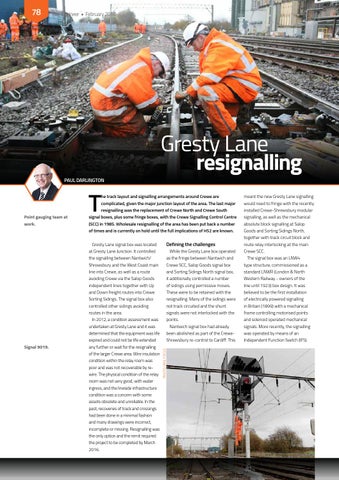Rail Engineer • February 2016
PAUL DARLINGTON
Point gauging team at work.
Signal 9019.
Gresty Lane resignalling
T
he track layout and signalling arrangements around Crewe are complicated, given the major junction layout of the area. The last major resignalling was the replacement of Crewe North and Crewe South signal boxes, plus some fringe boxes, with the Crewe Signalling Control Centre (SCC) in 1985. Wholesale resignalling of the area has been put back a number of times and is currently on hold until the full implications of HS2 are known. Gresty Lane signal box was located at Gresty Lane Junction. It controlled the signalling between Nantwich/ Shrewsbury and the West Coast main line into Crewe, as well as a route avoiding Crewe via the Salop Goods independent lines together with Up and Down freight routes into Crewe Sorting Sidings. The signal box also controlled other sidings avoiding routes in the area. In 2012, a condition assessment was undertaken at Gresty Lane and it was determined that the equipment was life expired and could not be life extended any further or wait for the resignalling of the larger Crewe area. Wire insulation condition within the relay room was poor and was not recoverable by rewire. The physical condition of the relay room was not very good, with water ingress, and the lineside infrastructure condition was a concern with some assets obsolete and unreliable. In the past, recoveries of track and crossings had been done in a minimal fashion and many drawings were incorrect, incomplete or missing. Resignalling was the only option and the remit required the project to be completed by March 2016.
Defining the challenges While the Gresty Lane box operated as the fringe between Nantwich and Crewe SCC, Salop Goods signal box and Sorting Sidings North signal box, it additionally controlled a number of sidings using permissive moves. These were to be retained with the resignalling. Many of the sidings were not track circuited and the shunt signals were not interlocked with the points. Nantwich signal box had already been abolished as part of the CreweShrewsbury re-control to Cardiff. This PHOTO: RAIL FOCUS
78
meant the new Gresty Lane signalling would need to fringe with the recently installed Crewe-Shrewsbury modular signalling, as well as the mechanical absolute block signalling at Salop Goods and Sorting Sidings North, together with track circuit block and route relay interlocking at the main Crewe SCC. The signal box was an LNW4 type structure, commissioned as a standard LNWR (London & North Western Railway - owners of the line until 1923) box design. It was believed to be the first installation of electrically powered signalling in Britain (1899) with a mechanical frame controlling motorised points and solenoid operated mechanical signals. More recently, the signalling was operated by means of an Independent Function Switch (IFS)
